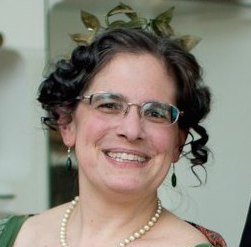I’ve had sequence dances on my mind recently after some discussion earlier this week, which reminded me of this little sequence from the the second edition of F. Leslie Clendenen’s 1914 compilation Dance Mad. It appears there under the name “American Grapevine Dance” by Anthony J. Giaconia of Springfield, Massachusetts. I know nothing about Mr. Giaconia except that on June 24, 1912, he was quoted on the front page of The Indianapolis News as one of a convention of dancing masters appalled by dances like the Grizzly Bear and Bunny Hug. He found some dancing in a park there so disgraceful that it ought to be stopped “for the sake of decency”.
The Grapevine Dance is so short (only eight bars) that it doesn’t feel long enough to be a sequence dance all on its own, but the two measures in which the dancers move directly into the center of the room and back make it mildly risky to use simply as a variation; moving abruptly back and forth across the line of dance can cause problems for dancers coming up behind. Doing this from an “inside lane” near the center of the room will be more polite if it is not being done in unison as a sequence dance.
The sequence is performed in a normal ballroom hold, traveling along the line of dance. The gentleman starts facing the wall and the lady the center of the room. He starts with the left foot and she with the right.
American Grapevine Dance (eight bars)
1b Three-slide galop & half-turn (slide-close-slide-close-slide, 1&2&3)
1b Three-slide galop & half-turn (slide-close-slide-close-slide, 4&5&6)
2b Four steps of grapevine (side-cross behind-side-cross front, 1234), then step to the side and close (56)
1b Three “trotting” steps straight back to center of the room (123)
1b Three “trotting” steps forward (456)
2b Four steps of grapevine (side-cross behind-side-cross front, 1234), then step to the side and close (56)
On the grapevines, the ladies cross in front first and then behind. On the trotting steps they move first forward then back.
The reconstruction is quite straightforward; the only part that gave me any pause was a note that
In making the first step in the Grapevine in part 2 from last movement of part 1, it is necessary for the gentleman to make a three-quarter turn to the right so that the gentleman’s back is turned to the line of direction and finish Grapevine from that position. This makes a very fascinating step.
That didn’t immediately make sense to me, but I think what is meant is that the dancers make a half-turn at the end of the second three-slide (which is done “over elbows”) to get back to their starting orientation (gentleman facing wall/lady center). The first step of the grapevine is sideways along the line of dance, but on the second (crossing) step, the man crosses behind and very briefly has his back to the line of dance before again stepping sideways along line of dance and crossing in front to finish the grapevine.
No specific music is given; the only advice is for slow 3/4 time, specifically “three-step music”. Three-step is one of those unusual dances that turn up very occasionally on dance cards (such as this 1910 one), but I haven’t done enough work with it to have a good feel for what makes a piece three-step music as opposed to waltz music. The sequence does work nicely with waltz music at about 120 beats per minute. It is quite leadable with a good follower, even one who does not know it.
Special thanks to Marci for demonstrating how leadable this dance is!


Leave a Reply